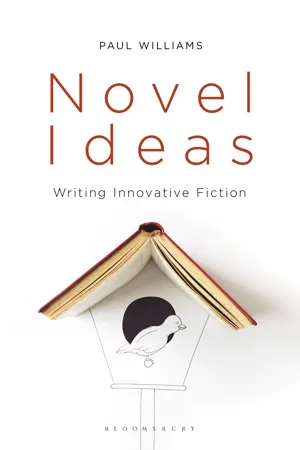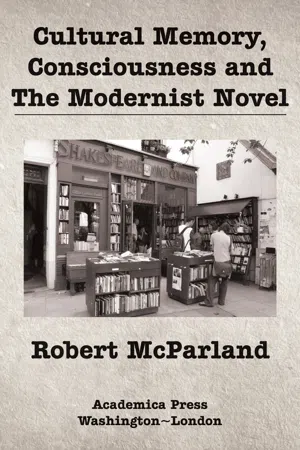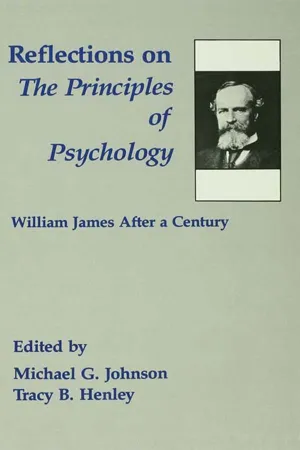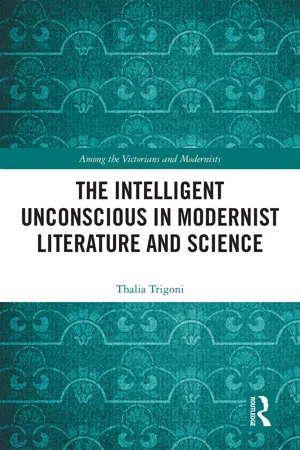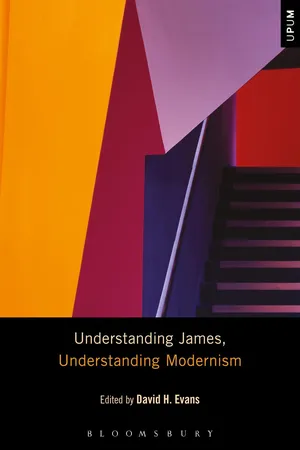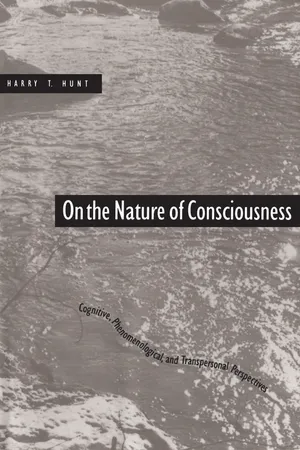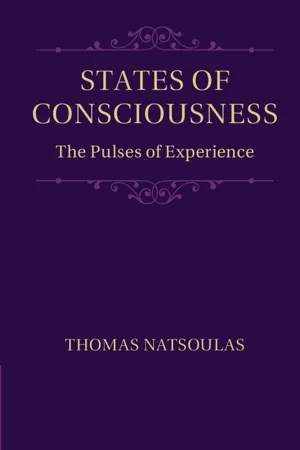Literature
Stream of Consciousness
Stream of consciousness is a narrative technique that aims to depict the continuous flow of thoughts, feelings, and sensations of a character in a literary work. It often lacks traditional structure and can be characterized by its fragmented and nonlinear style. This technique provides insight into the inner workings of a character's mind, offering a unique and intimate perspective for the reader.
Written by Perlego with AI-assistance
Related key terms
1 of 5
11 Key excerpts on "Stream of Consciousness"
- eBook - PDF
Novel Ideas
Writing Innovative Fiction
- Paul Williams(Author)
- 2019(Publication Date)
- Bloomsbury Academic(Publisher)
Stream of Consciousness is a metaphor that describes that continuous flow of sensations, impressions, images, memories and thoughts in our minds. Following William James, early Modernist writers wrote stream-of- consciousness narrative in order to provide a textual equivalent to the way we think and perceive the world. Such narratives create the impression that the reader is eavesdropping on the flow of conscious experience in the character’s mind. They use narrative devices such as psycho-narration, free indirect style, associative and dissociative leaps in content, and creative use of punctuation. James Joyce’s succession of novels A Portrait of the Artist as a Young Man (1916), Ulysses (1920) and Finnegan’s Wake (1939) experiment with this “stream”. In A Portrait of the Artist as a Young Man , we see the world from the streamed consciousness of Stephen Dedalus at school: They all laughed again. Stephen tried to laugh with them. He felt his whole body hot and confused in a moment. What was the right answer to the question? He had given two and still Wells laughed. But Wells must know the right answer for he was in third of grammar. He tried to think of Wells’s mother but he did not dare to raise his eyes to Wells’s face. It was Wells who had shouldered him into the square ditch the day before because he would not swap his little snuffbox for Wells’s sea-soned hacking chestnut, the conqueror of forty. It was a mean thing to do; all the fellows said it was. And how cold and slimy the water had been! And a fellow had once seen a big rat jump plop into the scum (Joyce, 2000 (1916), p. 11). In Ulysses , Joyce presents the reader with the raw interior conscious-ness of Leopold Bloom: if his nose bleeds youd think it was O tragic and that dying looking one off the south circular when he sprained his foot at the choir party at the sugarloaf Mountain the day I wore that - Robert McParland(Author)
- 2022(Publication Date)
- Academica Press(Publisher)
In response, Melvin Friedman, in 1955, viewed Stream of Consciousness as “a type, or form like a sonnet,” which is involved in “recording pure sensation and images” (6). Leon Edel, in the same year, recognized the “inward turning” of the novel and its writers in the 1920s. He resisted the definitions posed by Humphrey and Feldman. We ought not “to impose conventional order” on the moves that Joyce makes, he wrote. Edel saw that Ulysses offers an example of Joyce’s control of his technique. The reader adopts the position of the character, as he or she is placed within that character’s mind. “One becomes involved with its discontinuity or scrambled state,” Edel wrote (199). Frederick Hoffman, meanwhile, declared that “the psychological novel existed long before Freud’s work on the dream or his subsequent statements about the unconscious” (130). However, depth psychology has contributed to Stream of Consciousness. In his book The Twenties, Hoffman regards Stream of Consciousness as a pivotal technique of the age (246). Stream of Consciousness writing soon entered the mainstream in America, as Gregory Brister has shown with reference to popular writing on the emerging advertising industry (“The MainStream of Consciousness,” diss. University of Kansas, 2010). Harry Dexter Kitson wrote in The Mind of the Buyer: A Psychology of Selling (1921): “The mind is a stream.” This is “the sum total of mental processes going on within the individual” (4). We read: “The mind never stands still. It is in constant motion. The thought of one moment is quickly replaced by others” (Ibid). Words create images in the mind, Walter Dill Scott observes in The Psychology of Advertising (1921). He asserts that given increased awareness of the associative mind there has been an “inward turn” in consumers. Scott insists that “the successful advertiser must study psychology and […] he must do it at once” (84). (Gregory Brister, 2010, dissertation) Psychoanalysis was viewed popularly- eBook - ePub
- Nigel Krauth(Author)
- 2022(Publication Date)
- Multilingual Matters(Publisher)
Stream of Consciousness provides a contact point where literary studies, creative writing and science disciplines meet. While each discipline uses diverse terminology for mind phenomena, and each has given alternative designations to Stream of Consciousness itself, at an academic gathering of critics, writers and scientists, when ‘Stream of Consciousness’ is mentioned they all know what is being talked about. Ironically, we know also that ‘William James the scientist was critical of his artistic junior [Henry James], who played with the facts of life in words instead of putting them under a microscope’ (Edel, 1982: 125). The James brothers may have had their differences at the turn of the 20th century, but the study of the mind they advanced was ground-breaking for both psychology and creative writing. This chapter focuses on the roots of Stream of Consciousness in psychology, the ways it has been interpreted in literary studies to the present, and what creative writers might usefully gain from using the term as a tool in understanding their practice.The Complexity of the Stream of ConsciousnessThe dominant modes of cognition are our verbal and visual thinking. While the mind processes other modes which engage our perception organs (touch, taste, smell) as well as our emotions, memories, bodily actions, etc., ultimately they all involve the Stream of Consciousness, which is the mind-activity described by psychologist William James in 1884 as ‘the wonderful stream’ we are aware of inside our heads (James, W., 1884: 2), and is more recently explained by creativity researcher Mark A. Runco as our ‘inner psychic existence and functioning’ (Runco, 2011b: 228).Verbal thinking involves us using language in our minds. It is the wording, or voicing, that happens there: the monologue, the dialogue, the internal language experience (Fernyhough, 2010). While visual thinking (seeing images in our minds) also occurs, and cooperates significantly with verbal thinking in many situations, most of us think predominantly in language, or inner talk (Nęcka, 2011: 217–218). Scientists agree in principle that the two main ways we do our verbal thinking are convergent and divergent (Runco, 2011a; Russ & Dillon, 2011), analogous to writers recognising that mind-activity can be represented in a written work by linear sequential text or by non-linear fragmented text. Linear text reveals the mind working in logical, focused ways; non-linear text replicates mind-activity as less controlled and more messy. Writing in these different ways produces different sorts of narratives and narrative structures; different voices, plots and messages; and leads to recognition in different literary genres, either conventional or experimental. Scientists, correlatively, refer to convergent and divergent thinking and say that the former occurs where thinking operates to focus on an outcome, e.g. the solving of a problem, and leads logically or convergently towards an answer, while the latter explores creatively, draws possibilities in, and allows divergent associations to occur. Divergent thinking may be less targeted but it comes in handy for convergent problem-solving, too, e.g. in the form of brainstorming (Russ & Dillon, 2011: 70). It might be said that science generally favours thinking that leads directly to the pleasure of a resolution or an answer, i.e. science dislikes ambiguity and lack of resolution. But creative writing often favours thinking that leads to the pleasure of further possibility - eBook - ePub
Reflections on the Principles of Psychology
William James After A Century
- Michael G. Johnson, Tracy B. Henley, Tracy Henley, Michael Johnson(Authors)
- 2013(Publication Date)
- Psychology Press(Publisher)
Despite this, the author usually associated with this technique is James Joyce. In three novels, Portrait of the Artist, Ulysses, and Finnegans Wake, Joyce explores Stream of Consciousness technique as his characters move from the level of everyday (in Portrait and to some degree in Ulysses) to that of mythic intelligence and memory (parts of Ulysses and most of Finnegans Wake). Since the Stream of Consciousness as a psychological phenomena is of primary concern, it seems best to deal only with parts of Portrait and Ulysses, especially since the same character, Stephen Daedalus, appears in both. The first Stream of Consciousness in Portrait occurs on the very first page, which begins, without any indication such as quotation marks, with us listening to a story from the perspective of a very young child. As this mode of presenting personal experience continues, the reader is provided with examples of the streams of consciousness of a 6-year-old arriving at school and meeting a bully, of an adolescent watching a young woman bathe, and of a young man entering post-college life. Although a number of techniques are used to convey Stephen's experiences, most of the writing is in the third person. The only concession made to Stream of Consciousness style occurs when transitions in the text are not explicitly signaled: for example, when the child Stephen moves back and forth from the world of the present (an encounter with a bully) to that of the past (remembrances of sitting with mother by the fire). If there is an impression to be gotten from Portrait it is that of change: change in perspective (present/past, author/character, old/young), change in language and style (child/adolescent/college-age), and change in locale (the various way-stations of Stephen's life). The novel is not difficult to follow, and the reader seldom has trouble discerning whose Stream of Consciousness is whose. The situation in Ulysses is less clear - Thalia Trigoni(Author)
- 2020(Publication Date)
- Routledge(Publisher)
Virginia Woolf has long since been recognized as one of the most important writers who employed the literary technique of the Stream of Consciousness in their writings. Yet, despite the fact that it is a well-trodden aspect of Woolf’s art, it remains relatively understudied when it comes to its connections to the unconscious. A study of these connections has significant consequences for our understanding of her philosophical and ideological outlook, particularly in relation to gender identity. This chapter is divided into three sections. The first one concentrates on the historical and philosophical background of the Stream of Consciousness, paying particular attention to the writings of Herbart, Lewis, Sinclair, Richardson and James. The aim here is to address a significant gap in extant studies: the function of the unconscious in the Stream of Consciousness. The second section looks into the ways in which Woolf built on these theories in order to develop her own understanding of how the cognitive properties of the unconscious forge the paths of the Stream of Consciousness and affect the processes of creating and receiving literary art. The last section explores the ways in which her theory of the stream led her to technical developments and shaped her feminist project.The Historical Background of the Stream
The term “Stream of Consciousness” was coined by Alexander Bain in 1855 in The Senses and the Intellect .1 In the posthumous fifth volume of his major undertaking, Problems of Life and Mind (1879), George Henry Lewes (1817–1878) was the first to write a detailed discussion of the “Stream of Consciousness” in English.2 Lewes, nevertheless, acknowledged his debt for the concept of the stream to Gustav Theodor Fechner (1801–1887), the famous psychophysicist at the University of Leipzig.3 In his Elements of Psychophysics (1860), Fechner frequently used the metaphor of a mental wave (Welle ) to describe the thinking processes, drawing attention to the role played by the unconscious:If it [a stimulation] is below the level, or if it has no escort of excitations above the level, it is then said to be “not accompanied by consciousness”; this means that in and for itself the movement has had neither the interest which connects it with feeling, nor the significance which connects it with Thought.Lewes described the unconscious process that singles out what is significant and interesting, and he asserted the existence of a selective mechanism performing cognitive processes for the benefit of the individual. He provided as an example the somnambulist, “who moves securely through a crowded room, sees the objects and persons (since he avoids them) but is not conscious of them.”4 Lewes represented mental activity as a curve that “rises into the stage of consciousness, which having attained its maximum sinks into subconsciousness and without changing its course falls to the level of unconsciousness, perhaps again to rise with like gradation.”5- eBook - ePub
- David H. Evans(Author)
- 2017(Publication Date)
- Bloomsbury Academic(Publisher)
Virginia Woolf’s Mrs. Dalloway also achieves this quick-paced, chaotic effect: “In people’s eyes, in the swing, tramp, trudge; in the bellow and the uproar; the carriages, motor cars, omnibuses, vans, sandwich men shuffling and swinging; brass bands; barrel organs; in the triumph and the jingle and the strange high singing of some aeroplane overhead was what she loved; life; London; this moment of June.” 2 Joyce and Woolf portray features of the familiar Stream of Consciousness. It is sometimes simple, sometimes complex; sometimes polyphonous, often cacophonous; sometimes reflective, memorial, accompanied by a foreboding sense of being watched; other times, simply a flow of first-order experience, a mostly perceptual phenomenal flow. Images pile on images, while the grammar falls apart in fragmented or run-on sentences. In Joyce there is no punctuation at all, in Woolf a few semicolons. This makes things difficult for the reader who likes images right-sized, but it is perhaps more realistic, more representative of the way inner life is. Just as we might connect psychological behaviorism and literary style, we can consider the relation of Stream of Consciousness narration and psychological theory. William James’s famous chapter “The Stream of Thought” from The Principles of Psychology (PP ; 1890) is often cited in introductions to modernist literature. 3 Here we provide a reading of James’s famous chapter. At the end we reconnect his analysis of the stream with its literary doppelganger. The Stream of Consciousness The Principles of Psychology is a two-volume work intended to provide a comprehensive overview and analysis of the state of the new science of the mind, which some date to 1879 and the work of pioneers like Wilhelm Wundt in Leipzig. James reports, in the 1892 condensation of the book, that the new science consists mostly of “a string of raw facts; a little gossip and wrangle about opinions.. - eBook - PDF
- Robert Lerner, Althea K. Nagai, Stanley Rothman(Authors)
- 1995(Publication Date)
- Yale University Press(Publisher)
The Stream of Consdousness as Self-Transforming Dialogue Several features that James ascribes to the ongoing stream of awareness can seem contradictory: the stream is subjectively imposed and involuntary, yet always feels personal and mine. It constantly changes and transforms itself, but is sensibly continuous. These ostensible contraries, however, all follow from the self-referen-tial, recombinatory, and cross-modal bases of symbolic cognition—which will fi-nally stand forth more clearly in the study of transpersonal states than in the more daydreaming consciousness of James and related stream-of-consciousness novel-ists. WILLIAM JAMES 119 James begins his analysis in The Principles by calling attention to the way that consciousness, once noticed as such, simply goes on, independent of our own volition. He says, in a way certainly familiar to all scientists and artists who have felt that their best ideas come to them as if from outside, that it would be more descriptively accurate if we said it thinks or feeling happening now, in the same way that we say it rains. Simultaneously, each moment of the stream feels mine, with a sensed hereness at the core of our feeling of personal presence. Any implied contradiction is resolved, however, when in his next chapter, The Consciousness of Self, he points out that there is no phenomenal I in immediate consciousness. As further developed by G. H. Mead, consciousness itself is the only possible source for any spontaneous originating I. - eBook - PDF
States of Consciousness
The Pulses of Experience
- Thomas Natsoulas(Author)
- 2018(Publication Date)
- Cambridge University Press(Publisher)
However, the phrase “not conscious” would serve to signal that the fol- lowing is the case about all of those consciousnesses. They are considered mental occurrences, but fundamentally not of that kind of such as they have so far been widely understood to be. James (1890) consistently calls the Stream of Consciousness by the name the stream of thought. See through- out plus the title of his famous ninth chapter. He is thus in position to express his alternative claim that the stream of thought is not actually what it is commonly believed to be. Accordingly, the stream of thought is not in the final analysis such as recommends itself to qualify for made up of consciousnesses in the tradi- tional sense of that word. Rather, the stream essentially is composed wholly A Revisioning of the Stream of Consciousness 51 51 of what James dubs “sciousnesses.” This is a word of his construction for purposes of depicting the alternative position on offer. He has eliminated the prefix con- to indicate thereby that the basic durational components of the stream of thought are not in fact mental occurrences whereof there ever transpires the most intimate kind of cognition that inner awareness is overwhelmingly considered to be. One’s sciousnesses are interpreted by James (1890) as occurrences tran- spiring within one and also as cognitional events no less cognitional than what is commonly held to be the case with regard to consciousnesses. But the apparent truth of the alternative view is at this point producing inroads to James’s understanding of what is involved in that inner process, the stream of thought. Consequently, he claims that one’s sciousnesses are mental occurrences to which in relation one stands otherwise as compared to how one is said to stand to one’s traditional consciousnesses. - eBook - PDF
Point of View in the Cinema
A Theory of Narration and Subjectivity in Classical Film
- Edward Branigan(Author)
- 2012(Publication Date)
- De Gruyter Mouton(Publisher)
216 Appendix 5. From Literature to Film: Narration as Consciousness The most thoroughgoing attempt so far to translate a traditional understanding of literary point of view to film has been made by Bruce Kawin. Although Kawin be-gins by dividing film narration into first, second, and third person, what truly de-fines his project as traditional and literary is the insistence on a unified, and unify-ing, consciousness who somewhere narrates the work. The assumption of classical philosophy is of an undivided subject which aspires to be at One with itself, with its perception, with the world, or with God. 104 The idea of a unified consciousness underpins the schemes of Booth, Friedman, and Kawin as well as such writers as Pipolo, Andrew, and Browne. The search for consciousness extends even to critics dealing with experimental and non-narrative films. 105 The search derives, I be-lieve, from something like the historical scenario proposed by Jean-Paul Sartre: After the age of objective and metaphysical realism, when the words of the tale were taken for the very things which they named and when its substance was the universe, there came that of literary idealism in which the word has exis-tence only in someone's mouth or on someone's pen and refers back in essence to a speaker to whose presence it bears witness, where the substance of the tales is the subjectivity which perceives and thinks the universe, and where the novelist, instead of putting the reader directly into contact with the object, has become conscious of his role of mediator and embodies the mediation in a fic-titious recital. 106 Sartre adds that the device of the interior monologue pushes the hypothesis of a personal subjectivity to the limit and strives for realism by leading idealism to the absolute. The reality which one shows to the reader without intermediary is no longer the thing itself — the tree, the ashtray — but the consciousness which sees the thing. - eBook - PDF
More Examples, Less Theory
Historical Studies of Writing Psychology
- Michael Billig(Author)
- 2019(Publication Date)
- Cambridge University Press(Publisher)
James could equally have repeated Tucker’s description that perceptions flow in without intermission. James went on to stress that consciousness was not chopped up into bits or constructed from putting those bits together: ‘A “river” or a “stream” are the metaphors by which it is most naturally described’. He declared that henceforth we should refer to ‘the stream of thought, of consciousness, or of subjective life’ (p. 239, emphasis in original). Tucker used the same metaphor of a river. He argued that the mind is both active and passive. We cannot completely control our thoughts, even if we are deliberating upon an issue intently, rather than staring out of the window. The thinker is like a hound sniffing a trail: we might decide to follow the trail but we have not laid it down, so that we do not know where it might lead. The mind only begins a train of thinking ‘but the thoughts introduce one another successively’ (1768, 1, i, p. 11). As such, Tucker says we can compare the thinker to a ‘man who has a river running through his grounds’ (p. 12). The river might break into several channels; if the landowner tries to dam up one of the channels, the river still flows through others. The flow of the river is unstoppable, and so it is with our thoughts which ‘are perpetually working so long as we are awake’ (p. 13). We may divert our thoughts but we ‘can never totally prevent them from moving’ (p. 13). Stream of Thought 67 The river of consciousness for James meant that thoughts and feelings never repeat themselves in exactly the same way: there is always move- ment and change. Tucker emphasised another point, from which James would surely not have dissented. However much we try to control our thoughts – and both James and Tucker agreed we should try to – we can seldom, if ever, succeed in fully retaining control. Our conscious life happens to us, as much, if not more, than we direct it to happen. - eBook - ePub
- Elijah Chudnoff(Author)
- 2015(Publication Date)
- Routledge(Publisher)
phenomenal event are notions of types. Streams of consciousness relate times to instances or temporal parts of instances of these types. Third, the reason for adding the qualification “or temporal parts of” is that some phenomenal events persist, but as pointed out above, they do so by having temporal parts. For a temporally extended phenomenal event to occur to one is for one’s Stream of Consciousness to assign its different temporal parts to the appropriate times. Fourth, streams are not functions from times to instances of phenomenal states or temporal parts of phenomenal events. They are relations between times and instances of phenomenal states or temporal parts of events. Unlike functions, relations can be one-many. This allows a stream to assign more than one token phenomenal state or temporal part of a phenomenal event to the same time. Contrast the motion of a particle: at any one time it is at just one place, so we can use a function to represent that motion.Now we will build on the minimal notion, following James’s discussion in the Principles of Psychology. The chapter in which James discusses the Stream of Consciousness is entitled “The Stream of Thought.” In it James defends five claims. Here are his initial formulations of them:- Every thought tends to be part of a personal consciousness.
- Within each personal consciousness thought is always changing.
- Within each personal consciousness thought is sensibly continuous.
- It always appears to deal with objects independent of itself.
- It is interested in some parts of these objects to the exclusion of others, and welcomes or rejects – chooses from among them, in a word – all the while.2
As a preliminary point it is important to observe that James is using “thought” to mean “every form of consciousness indiscriminately.”3 So his theses are about sensory perceptions, bodily sensations, emotions, moods, and various conscious cognitive states. Because this book is about the distinctive properties of cognitive states as opposed to sensory states and this chapter is about the distinctive properties of conscious thoughts narrowly construed as opposed to both sensory states and other cognitive states, I will not use the term “thought” in the way James uses it. Instead of introducing a single alternative term to mean what James meant by “thought” I will continue to use the terms I have already been using – “phenomenal state,” “phenomenal event,” “phenomenally conscious state,” “phenomenally conscious event” – and one other term – “item in a Stream of Consciousness.”An item in a Stream of Consciousness is anything that belongs to that Stream of Consciousness. Mathematical discussions of relations use the notions of domain and range. Relations associate members of the domain to members of the range. For streams of consciousness the domain contains times and the range contains phenomenal states and temporal parts of phenomenal events. So we can say that something is an item in a Stream of Consciousness just in case it is in the range of the relation representing that Stream of Consciousness. This is the notion I will use in discussing James. I believe it picks out the same assortment of things he intended to pick out by the term “thought,” i.e. “every form of consciousness indiscriminately.”
Index pages curate the most relevant extracts from our library of academic textbooks. They’ve been created using an in-house natural language model (NLM), each adding context and meaning to key research topics.
